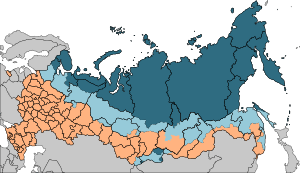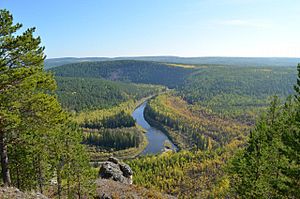Far North (Russia) facts for kids
The Extreme North or Far North (called Krayniy Sever in Russian) is a huge part of Russia. It is mostly located north of the Arctic Circle, which is a very cold area. This region is known for having lots of valuable minerals and other natural resources.
This vast area covers about 5,500,000 square kilometers (about 2,100,000 square miles). That's about one-third of Russia's total size! The Extreme North includes places like Chukotka Autonomous Okrug, Kamchatka Krai, Magadan Oblast, Murmansk Oblast, and Sakha. It also covers parts of many other regions, such as Arkhangelsk Oblast and Komi Republic. All the islands in the Arctic Ocean, the Bering Sea, and the Sea of Okhotsk are also part of this region.
Life in the Extreme North is very challenging because of the harsh, cold weather. Because of these tough conditions, people who work there usually get paid more by the Russian government. This extra pay helps make up for the difficult environment. The local people who have lived here for a long time have even developed special ways to live in this cold climate. Their bodies and cultures have adapted to the unique environment.
Major Cities in the Far North
Many cities are found in the Extreme North, even with its cold climate. These cities are home to many people.
Some of the largest cities in the Russian Far North include:
- Arkhangelsk (with about 349,742 people)
- Yakutsk (with about 322,987 people)
- Murmansk (with about 287,847 people)
- Severodvinsk (with about 181,990 people)
- Norilsk (with about 181,830 people)
- Petropavlovsk-Kamchatsky (with about 181,216 people)
- Novy Urengoi (with about 118,033 people)
- Noyabrsk (with about 110,620 people)
- Magadan (with about 92,052 people)
The city of Surgut is also very large, with about 380,632 people. It is located a bit further south but is considered a territory "equated" to the Far North.
Special Benefits for Workers
The Extreme North is famous for its very harsh climate. To encourage people to work there, the Russian government gives special benefits. These benefits are for workers who are not from the local indigenous groups or those in traditional jobs.
One main benefit is extra pay, called the "Northern Bonus" (severnye nadbavki in Russian). Workers also get more vacation time and better retirement benefits. This means they can retire at a younger age. They also receive help with housing. These benefits help make up for the difficult working and living conditions. This system of benefits started when Russia was part of the Soviet Union and continues today.
In 2007, a special committee in the Russian government worked on a new law. This law aimed to clearly define which parts of the Extreme North would get these benefits. It also decided how much compensation workers would receive. The plan was to give more benefits to people working in the coldest and harshest areas.
See also
 In Spanish: Extremo Norte ruso para niños
In Spanish: Extremo Norte ruso para niños



